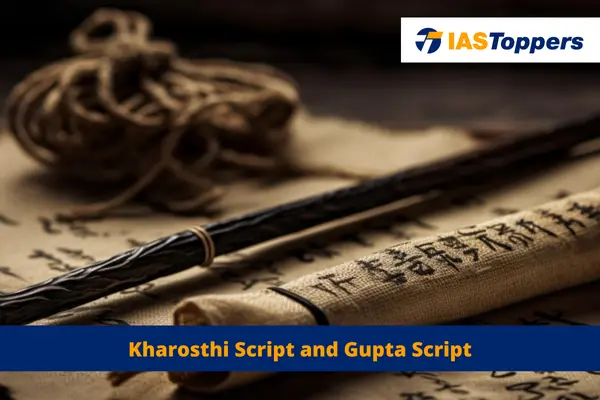Kharosthi Script is an ancient script utilized in the ancient Gandhara region (present-day Afghanistan and Pakistan) to write Gandhari Prakrit and Sanskrit. Gupta Script is associated with the Gupta Empire and were used to write Sanskrit. In this article, you will learn definition, features of Kharosthi Script and Gupta Script, providing key insights for GS Paper-I Art and Culture section of UPSC IAS Exam.
Table of Content
- About Gupta Script
- Features of Gupta Script
- About Kharosthi Script
- Features of Kharosthi Script
- Conclusion
- Frequently Asked Questions
- Reference
About Gupta Script:
- Gupta Script is associated with the Gupta Empire and were used to write Sanskrit.
- The Gupta script was descended from the Ashokan Brāhmī script, and is a crucial link between Brahmi and most other Brahmic scripts.
- The surviving inscriptions of the Gupta script includes Prayagraj (Allahabad) Prasasti, which was composed by Harisena, the court poet and minister of Samudragupta.
- It was sometimes referred to as Gupta Brahmi script or Late Brahmi script.
Features of Gupta Script
- Gupta Script is primarily written from left to right.
- Letters are grouped the way they are pronounced.
- Gupta Script has given rise to the Nagari, Sarada, and Siddham Scripts.
- Gupta Script has influenced many scripts in India including Devanagari, Gurmukhi Script (for Punjabi Language), Assamese Script, Bengali Script, and Tibetan Script.
About Kharosthi Script
- It is an ancient script utilized in the ancient Gandhara region (present-day Afghanistan and Pakistan) to write Gandhari Prakrit and Sanskrit.
- It was used from the 3rd century BC to the 3rd century AD.
- The name Kharosthi may have been derived from the Hebrew kharosheth, a Semitic word for writing, or from Old Iranian which means “royal writing”
- Brahmi script had replaced the use of Kharosthi Script or Gāndhārī script.
- It is also known as Indo-Bactrian script.
- It was earlier also known as “Indo-Bactrian script“, “Kabul script” and “Arian-Pali“.
- It is closely related to Brahmia as it also follows an abugida structure.
- It was first time deciphered by James Prinsep.
- It was used in Bactria, Kushan Empire, Sogdia, and along the Silk Road and may have survived until the 7th century in Khotan and Niya, both cities in East Turkestan.
Features of Kharosthi Script:
- Kharosthi Script includes a set of numerals similar to Roman numerals, such as I and X.
- Kharosthi Script is predominantly written from right to left, but some inscriptions have also exhibited a left-to-right direction.
- Kharosthi Script was derived from Aramaic script which was used in the Achaemenid Empire.
Conclusion
The use of Kharosthi in ancient Indian architecture is the result of India’s contact with Greece. The script was then incorporated into many Indian architecture. Gupta Script has influenced scripts of many other Indian languages. The Gupta Script stands as a testament to the artistic and intellectual achievements of ancient India during the Gupta Empire. The Gupta script is the ancestor of many later Indian scripts, such as Devanagari, Bengali, and Gujarati. It played a crucial role in the standardization of Sanskrit literature and epigraphy. Kharosthi and Gupta scripts are integral to the study of ancient Indian history. The study of inscriptions in these scripts provides valuable information about the governance, economy, and religious practices of their respective periods. These scripts highlight the diversity and evolution of writing systems in India, showcasing the rich cultural heritage of the country.
Ref: Source-1
| Other Articles in History & Culture | |
| Guru Nanak | Prehistoric Rock Paintings in India |
| Chalukya Dynasty | Magadha Empire |
| Ashoka’s Dhamma | Indus Valley Civilization Sculpture |
FAQs (Frequently Asked Questions)
In which direction the Kharosthi Script was written?
Kharosthi Script is mainly written from right to left, but some inscriptions have also exhibited a left-to-right direction.
Which scripts were derived from the Gupta Script?
Gupta Script has given rise to Nagari, Sarada, and SiddhamScripts.
Who has deciphered the Kharosthi Script?
Kharosthi Script was first time deciphered by James Prinsep.



